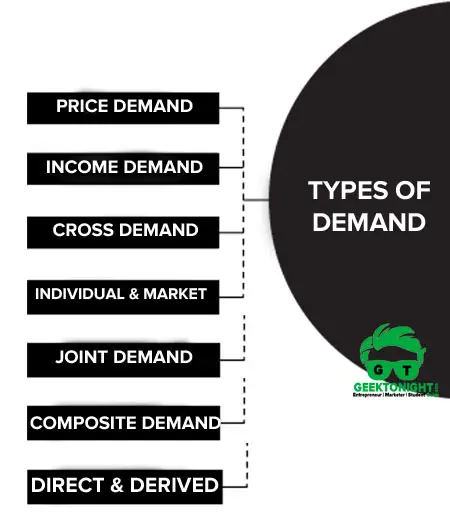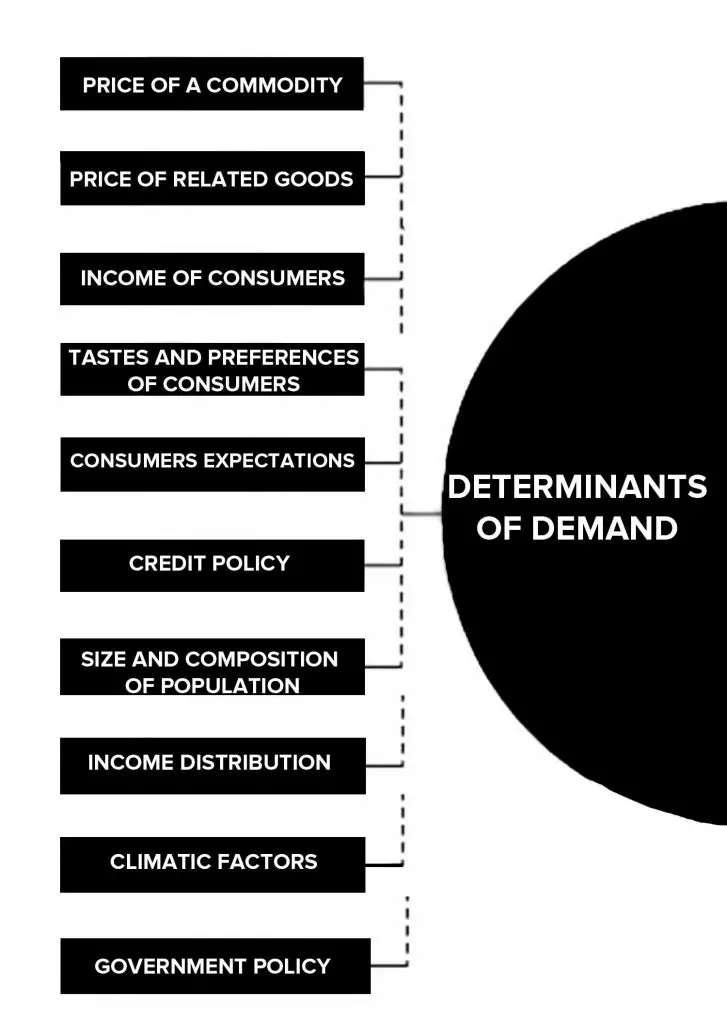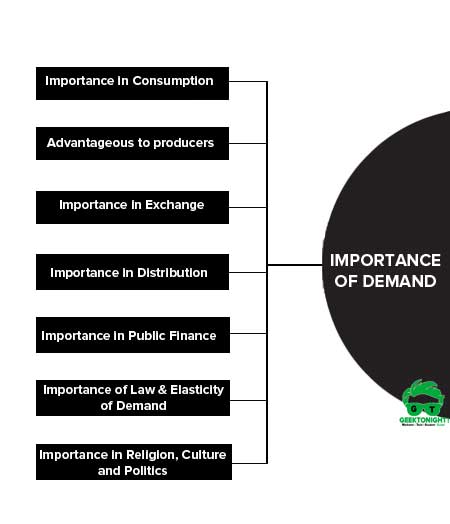What is Demand in Economics?
Demand in Economics is an economic principle can be defined as the quantity of a product that a consumer desires to purchase goods and services at a specific price and time.
Factors such as the price of the product, the standard of living of people and change in customers’ preferences influence the demand. The demand for a product in the market is governed by the Laws of Economics

Table of Content
A market is a place where individuals, households, and businesses are engaged in the buying and selling of products and services through various modes.
The working of a market is governed by two forces, which are demand and supply. These two forces play a crucial role in determining the price of a product or service and size of the market.
Introduction to Demand in Economics
Demand in economics is a relationship between various possible prices of a product and the quantities purchased by the buyer at each price. In this relationship, price is an independent variable and the quantity demanded is the dependent variable.
In a market, the behavior of consumer can be analysed by using the concept of demand.
Also Read: What is Business Economics?
Meaning of Demand in Economics
In economics by demand, we mean the various quantities of a given good or service which buyer would purchase in one market during a given period of time, at various prices, or at various incomes, or at various prices of related goods.
Definition of Demand in Economics
We can divide the definitions of demand given by various economists into three Categories:
To consider demand as an effective desire
According to Person – “Demand implies three things
- desire to possess a thing
- means for purchasing it;
- willingness to use those means for purchasing.”
According to this definition there is no difference between demand and want, demand is considered as a synonym of want.
Definition of demand in relation to price
Some learned economists have expressed their views by co-relating demand with price.
Prof. Mill has expressed: “We must mean by the word demand the quantity demanded and remember that this is not a fixed quantity but in general varies according to value.”
In the, words of Waugh, “The demand for any commodity is the relationship between the price and the quantity that will be purchased at that price.”
Definition of Demand in relation to Price as well as Time
Mayers and Benham are worth mentioning economists who are of the view that demand is related, with both, price as well as time.
In the words of Mayers “The demand for goods is a schedule of the amount that buyers would be willing to purchase at all possible prices at one instant of time.”
According to Benham “The demand for anything at a given price, is the amount of it which will be bought per unit of time at that price.”
Essentials of Demand
- To have an effective desire and ability to fulfil the desire and willingness to use those resources for fulfilment of the desire. It means consumer has a need and money to buy it.
- Demand for a particular commodity is related with a particular price for it;
- Demand for a particular commodity is related with per unit of time (daily, weekly, monthly, yearly etc.)
Also Read: What is Demand Schedule?
Demand Example
- Demand is always referred to in terms of price and bears no meaning if it is not expressed in relation to price.
For example, an individual may be willing to purchase a shirt at a price of 500 but may not be willing to purchase the same shirt if it is valued at 1000. In addition, different quantities of a commodity are demanded at different prices. - Demand is always referred in terms of a time period and bears no meaning if it is not expressed in relation to a time period.
For example, a garment manufacturer has a demand for 200 metres of cloth in a month or 2400 metres of cloth in a year.
A statement referring to demand for a commodity or service must include the following three key factors:- The quantity to be purchased
- The price at which the commodity is to be purchased
- The time period when the commodity is purchased
Also Read: What is Supply?
Types of Demand in Economics
7 Types of Demand in Economics are:
- Price Demand
- Income Demand
- Cross Demand
- Individual demand and Market demand
- Joint Demand
- Composite Demand
- Direct and Derived Demand

Price Demand
Price demand is a demand for different quantities of a product or service that consumers intend to purchase at a given price and time period assuming other factors, such as prices of the related goods, level of income of consumers, and consumer preferences, remain unchanged.
Price demand is inversely proportional to the price of a commodity or service. As the price of a commodity or service rises, its demand falls and vice versa.
Therefore, price demand indicates the functional relationship between the price of a commodity or service and the quantity demanded. It can be mathematically expressed as follows:
Therefore, price demand indicates the functional relationship between the price of a commodity or service and the quantity demanded. It can be mathematically expressed as follows:
DA= f (PA) where,
DA = Demand for commodity A
f = Function
PA =Price of commodity A
Income Demand
Income demand is a demand for different quantities of a commodity or service that consumers intend to purchase at different levels of income assuming other factors remain the same.
Generally, the demand for a commodity or service increases with an increase in the level of income of individuals except for inferior goods. Therefore, demand and income are directly proportional to normal goods whereas demand and income are inversely proportional to inferior goods.
The relationship between demand and income can be mathematically expressed as follows:
DA = f ( YA ), where,
DA = Demand for commodity A
f = Function
YA = Income of consumer A
Cross Demand
Cross demand is refers to the demand for different quantities of a commodity or service whose demand depends not only on its own price but also the price of other related commodities or services.
For example, tea and coffee are considered to be the substitutes of each other. Thus, when the price of coffee increases, people switch to tea. Consequently, the demand for tea increases. Thus, it can be said that tea and coffee have cross demand.
Mathematically, this can be expressed as follows:
DA = f (PB), where,
DA = Demand for commodity A
f = Function
PB = Price of commodity B
Individual demand and Market demand
Individual demand and market demand: This is the classification of demand based on the number of consumers in the market. In dividual demand refers to the quantity of a commodity or service demanded by an individual consumer at a given price at a given time period.
For example, the quantity of sugar that an individual or household purchases in a month is the individual or household demand. The individual demand of a product is influenced by the price of a product, the income of customers, and their tastes and preferences.
On the other hand, market demand is the aggregate of individual demands of all the consumers of a product over a period of time at a specific price while other factors are constant.
Joint Demand
Joint demand is the quantity demanded two or more commodities or services that are used jointly and are, thus demanded together.
For example, car and petrol, bread and butter, pen and refill, etc. are commodities that are used jointly and are demanded together.
Composite Demand
Composite demand is the demand for commodities or services that have multiple uses. For example, the demand for steel is a result of its use for various purposes like making utensils, car bodies, pipes, cans, etc.
For example, the demand for steel is a result of its use for various purposes like making utensils, car bodies, pipes, cans, etc. In the case of a commodity or service having composite demand, a change in price results in a large change in the demand. This is because the demand for the commodity or service would change across its various usages.
Direct and Derived Demand
Direct and derived demand: Direct demand is the demand for commodities or services meant for final consumption. This demand arises out of the natural desire of an individual to consume a particular product.
For example, the demand for food, shelter, clothes, and vehicles is direct demand as it arises out of the biological, physical, and other personal needs of consumers.
On the other hand, derived demand refers to the demand for a product that arises due to the demand for other products.
For example, the demand for cotton to produce cotton fabrics is derived demand.
Also Read: Types of Demand in Economics
Determinants of Demand
Determinants of demand are the factors that influence the decision of consumers to purchase a commodity or service.

- Price of a commodity: The price of a commodity or service is generally inversely proportional to the quantity demanded while other factors are constant.
- Price of related goods: The demand for a good or service not only depends on its own price but also on the price of related goods.
- Income of consumers: The level of income of individuals determines their purchasing power.
- Tastes and preferences of consumers: The demand for commodity changes with changes in the tastes and preferences of consumers
- Consumers expectations: Demand for commodities also depends on the consumers’ expectations regarding the future price of a commodity, availability of the commodity, changes in income.
- Credit policy: The credit policy of suppliers or banks also affects the demand for a commodity.
- Size and composition of the population: An increase in the size of a population increases the demand for commodities as the number of consumers would increase.
- Income distribution: Unequal distribution of income results in differences in the income status of different individuals in a nation.
- Climatic factors: The demand for commodities depends on the climatic conditions of a region such as cold, hot, humid, and dry.
- Government policy: Government policies have direct impact on the demand for various commodities.
Read Complete: 10 Determinants of Demand
Importance of Demand
Demand is considered the basis of the entire process of economic development, hence demand plays an important role in the economic, social and political fields.
The importance of demand are:
- Importance in Consumption
- Advantageous to producers
- Importance in Exchange
- Importance in Distribution
- Importance in Public Finance
- Importance of Law of Demand and Elasticity of Demand
- Importance in Religion, Culture and Politics

Importance in Consumption
Demand implies the schedule of quantities to be purchased over a specific period of time at various prices. A consumer determines the quantity of various commodities to be consumed on the basis of his demand.
Advantageous to producers
Producers maximize the profit by determining the nature, variety, quantity and cost of production on the basis of demand of various commodities and controlling the supply at an appropriate time.
Importance in Exchange
Quantity demanded is the purchase of a commodity in certain quantity at a certain price, therefore it is exchanged. This means that production, purchase and sale of a particular commodity of a particular quality and quantity takes place in demand and it is the process of exchange.
Importance in Distribution
Aggregate social production is determined on the basis of social demand. Production scale is increased with an increase in demand. Resources from various sources are procured to fulfill this increased demand. The share in the national product of a factor of production depends upon its demand.
Importance in Public Finance
Maximization of social welfare is the prime objective of the process of public finance. Sources of public revenue (inflows) and items of public expenditure (outflows) are determined to achieve this objective.
Importance of Law of Demand and Elasticity of Demand
The Law of Demand and Elasticity of demand is the most important concept in economics.
Importance in Religion, Culture and Politics
Demand of various commodities in society at various points of time is also very important from the religious, cultural and political points of view. Efforts are made to fulfill the demand of various commodities that arises at the time of various social or religious festivals.
Also Read: What is Demand Function
Business Economics Tutorial
(Click on Topic to Read)
Go On, Share article with Friends
Did we miss something in Business Economics Tutorial? Come on! Tell us what you think about our article on What is Demand | Business Economics in the comments section.
Business Economics Tutorial
(Click on Topic to Read)











